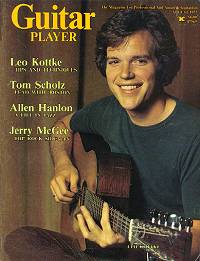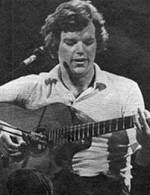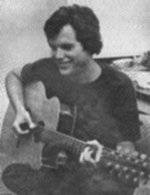Leo Kottke: His Techniques, Guitars, Slide, & Tricks of the Trade
by Gil Podolinsky
 |
Five years ago GP referred to 6- and 12-string guitar player Leo Kottke as a young fingerstylist on the horizon, fast becoming known to guitarists through word of mouth and his latest Capitol release, Mudlark. Kottke was linked to such commercially tangent, self-taught guitarists as John Fahey and Ry Cooder. The artist's sound was loosely defined as an integration of a wealth of styles: ragtime, folk, bluegrass, country and western, classical and bottleneck. Other pop music journals reflected the persistently uncategorizable quality of Kottke's music. If you like classifications, one critic piped, here's a new one: pop virtuoso.
Fellow guitarists and guitar fanatics have been responsible for a large measure of Kottke s fame; GP readers have voted him Best Folk Guitarist for the past three years. Yet in January of this year, Leo was featured in People magazine -- hardly a guitar society's newsletter.![]() In the all-seeing eye of the public, Kottke's reputation had spread beyond the musician's grapevine to a weekly read by millions. How to account for the rapidly growing artistic and personal draw of this somewhat reclusive, humorously introspective, and distinctly non-pop Minnesota eccentric? Of course it's his guitar playing.
In the all-seeing eye of the public, Kottke's reputation had spread beyond the musician's grapevine to a weekly read by millions. How to account for the rapidly growing artistic and personal draw of this somewhat reclusive, humorously introspective, and distinctly non-pop Minnesota eccentric? Of course it's his guitar playing.
 |
In addition to nine solo albums, Leo s work has been used on TV sermonettes and shows such as The Dating Game, on weather and traffic reports, and in concert halls and campuses across the nation. Perhaps all this diversity helps to explain the elusiveness of Kottke's musical and personal image.
 |
In notable opposition, however, to the Kottke mystique is the interview which follows. The artist is open, deliberate, and clear in imparting an unusually rich depth of insight into the structure of his own playing. -- GP